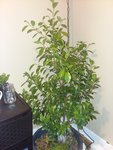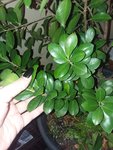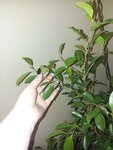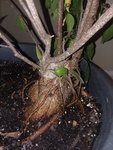@RachelPlantFan
You are in Georgia, there is a very active bonsai community in the Atlanta area.
You won't get much winter growth while the tree is indoors. If your tree were mine, I would:
1. - do nothing until spring. When nights are usually above 50 F put the tree outside for the summer. (April?)
2. In summer cuttings root very rapidly. You can take large diameter cuttings in June-August, they will root in a couple weeks and grow vigorously. You can root cuttings in winter ONLY IF you use a heated seed mat under the containers you root your cuttings in. Soil temp in winter needs to be 78 F to 85 F to get roots to grow. If you house is cool, like mine, nothing will happen, the cuttings will sit semi-dormant and slowly begin to rot. In my home, winter cuttings are a 100% failure.
3. Once it is warm enough to root cuttings, I would prune off all the understock growth - ginseng ficus - make that one group of cuttings. I would also make a few cuttings of the scion wood. The Ficus microcarpa 'Tiger Bark', You could easily end up with 5 or 10 trees to "play with".
4. The grafted Ficus with the fat tuber roots makes for a "bonsai - ish" plant that is more grotesque than handsome. Like desert rose and other pachycaul plants, they are enjoyed for their grotesqueness. The cuttings can be worked to make more tree like bonsai.
Ficus "Ginseng" ficus, this one is a little coarse in its foliage and internode lengths. These are best for larger scale trees, let your rooted cuttings get big, 4 foot or more tall, then cut back to less than 12 inches, then let grow out to 4 or 5 feet, then cut back keep a shorter segment. Repeat the cycle. I would shoot for bonsai in the 3 foot to 4 foot range. One design option would be the first 12 inches should be main trunk. Second 12 inches should be the sub trunks and major branches. The final 12 inches would be the fine branches with leaves. Essentially divide the tree in thirds. This is a generic tree design. Not a rule, just a suggestion if you don't know what to do. Another design suggestion, you want the trunk to be between a tenth to a third of the diameter of the height of the tree. The fatter the trunk relative to height the older looking the tree will be. A 3 foot tall ficus should have a trunk between 4 inches and 12 inches in diameter. Obviously any diameter over 6 inches in diameter is going to take time to develop. It won't happen right away.
The Ficus microcarpa probably the scion, it might be "tiger bark'' - the scion makes good bonsai at smaller sizes thru large size. You can probably make nice trees with the scion that finish around 12 inches tall to 24 inches tall. Similar 1/3rd, 1/3rd, 1/3rd plan, but you can do the segments at 4 inches intervals, for a 12 inch tall tree.
But this is all down the road. I would in late spring, as soon as the weather warms outside, put the tree outside, reduce the original to just foliage from scion branches, and make a bunch of cuttings of the rest. You can easily end up with dozens of ficus to practice with.






